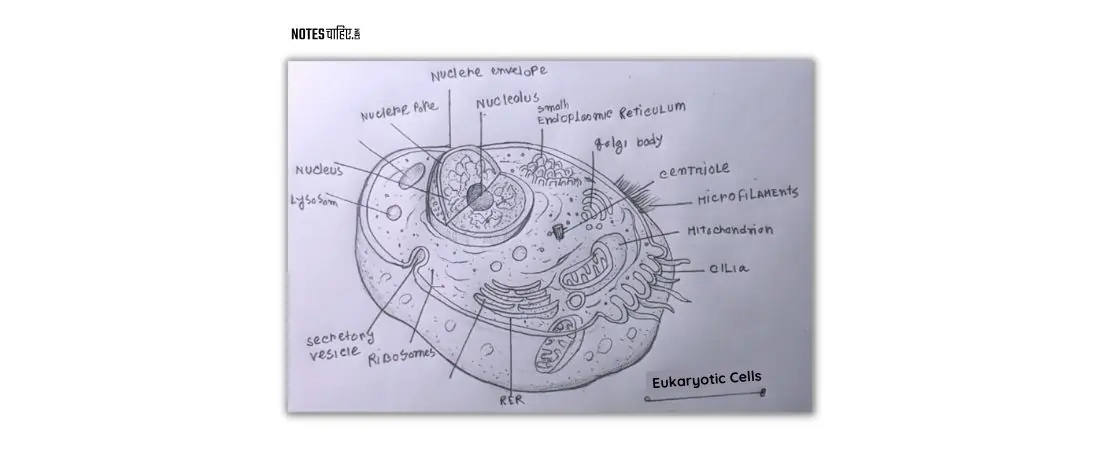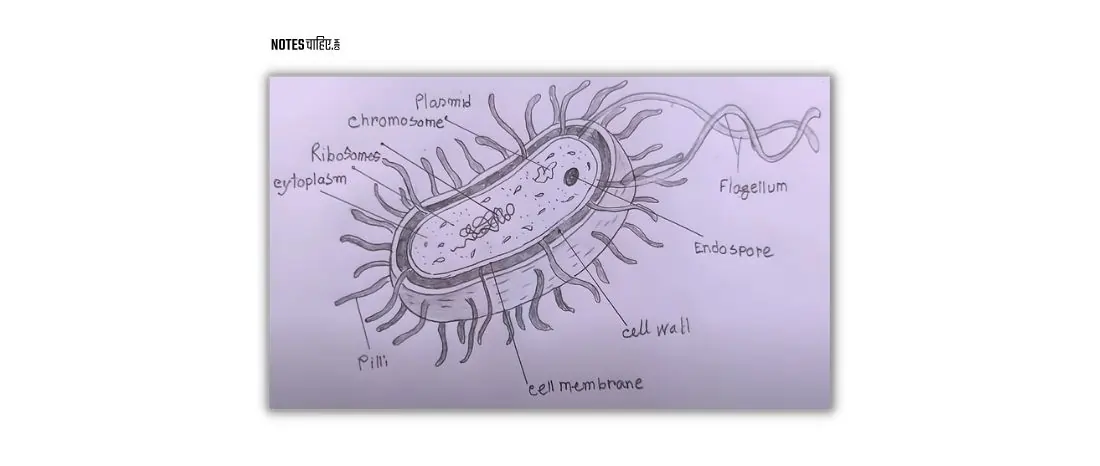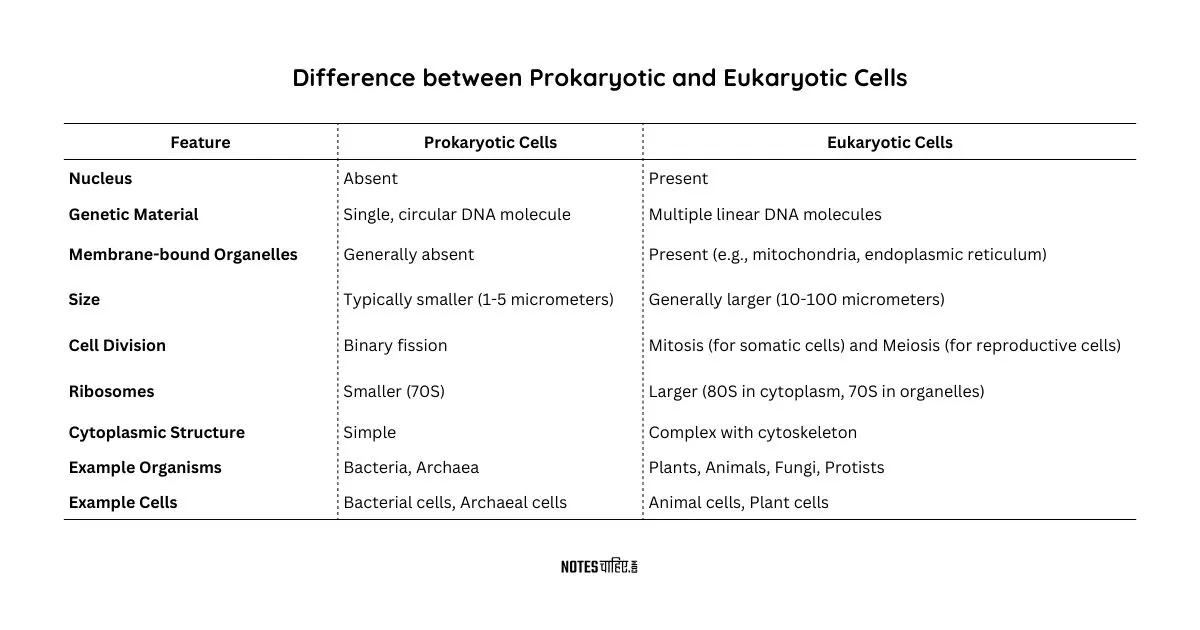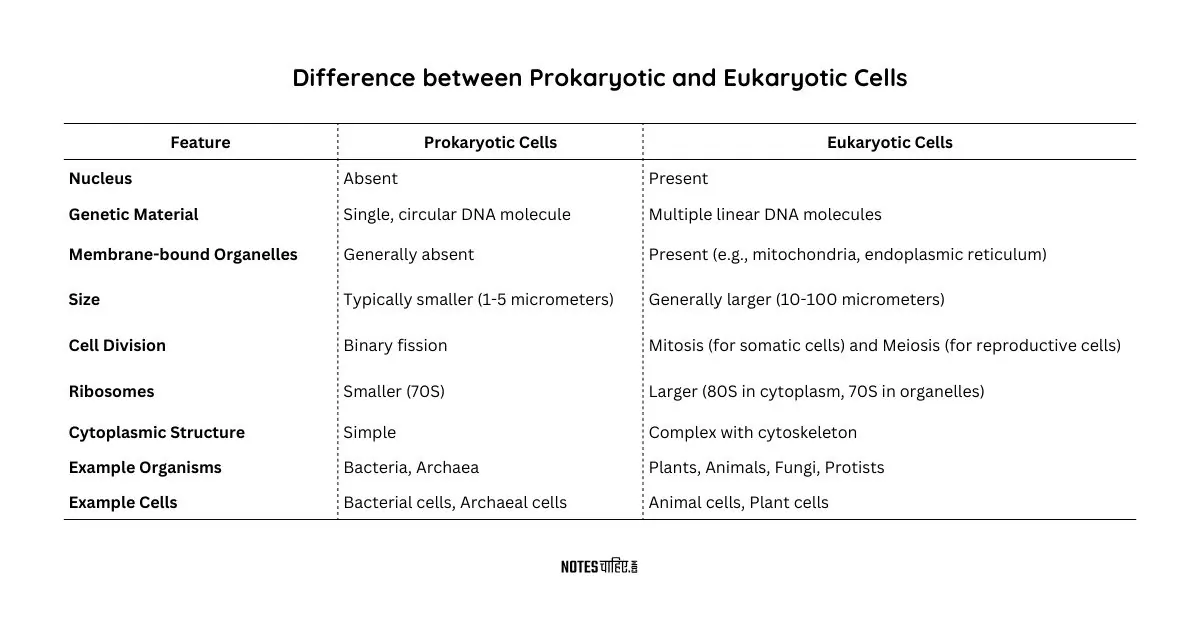In this article we have completed a query Difference between Prokaryotic and Eukaryotic Cells in Tabular Format. You can find parts and function of these cells.
About Eukaryotic Cell Parts
The term “prokaryote” originates from the Greek words “pro” (meaning: before) and “karyon” (meaning: kernel), translating to “before nuclei.” Fossil records indicate prokaryotes, ancient organisms thriving nearly 3.5 billion years ago, adapting to diverse environments.
Prokaryotic cells, smaller and simpler than eukaryotic cells, lack membrane-bound organelles like a nucleus. Reproduction occurs via binary fission.

The protective capsule prevents phagocytosis, and attachment pili resist flushing. The cell wall provides rigidity, enclosing cytoplasm with ribosomes for protein synthesis.
Some prokaryotes have mesosomes for cellular respiration and plasmids containing DNA. Flagella aid locomotion.
Bacteria and archaea exemplify prokaryotic organisms in Kingdom Monera.
- Cell Membrane: Acts as a selective barrier, regulating molecular passage in and out.
- Nucleus: Controls cell functions, housing DNA within a protective membrane.
- DNA: Genetic material containing instructions for protein synthesis.
- Endoplasmic Reticulum (ER): Network of membranes involved in protein production and transport.
- Ribosomes: Cellular structures synthesizing proteins based on DNA instructions.
- Lysosomes: Contain enzymes for breaking down cellular waste and maintaining cleanliness.
- Golgi Apparatus: Packages and distributes proteins within or outside the cell.
- Mitochondria: Generates ATP, serving as the cell’s energy source.
- Cytoplasm: Gel-like fluid filling the cell and facilitating various cellular functions.
About Prokaryotic Cell Parts:
The term “Eukaryotes,” derived from “eu” (meaning: good) and “karyon” (meaning: kernel), signifies “good or true nuclei.” Eukaryotes, more complex and larger than prokaryotes, encompass major kingdoms excluding Monera.
They feature a cell wall supporting and protecting the plasma membrane. The nucleus, surrounded by a nuclear membrane, houses DNA, and the nucleolus aids protein synthesis.

Eukaryotes have mitochondria for energy production and, in plants, chloroplasts for photosynthesis.
The endoplasmic reticulum facilitates material transport, with additional organelles like ribosomes, lysosomes, Golgi bodies, cytoplasm, chromosomes, vacuoles, and centrosomes. Eukaryotes include unicellular organisms with nuclei and multicellular organisms.
- Cell Membrane: Regulates molecular passage without cholesterol, simpler in structure.
- Nucleoid: Concentrated area of circular DNA, lacking a membrane.
- Pilus: Hair-like appendage facilitating cell attachment and genetic material exchange.
- Capsule: Sticky layer for protection against dehydration, predators, and the immune system.
- Cell Wall: Rigid structure made of peptidoglycan, providing support and protection.
- Flagellum: Whip-like tail enabling movement and navigation in some prokaryotes.
Science Notes Class 10 PDF Download 2024 (Rationalised)
Difference between Prokaryotic and Eukaryotic Cells (Table)

| Feature | Prokaryotic Cells | Eukaryotic Cells |
|---|---|---|
| Nucleus | Absent | Present |
| Genetic Material | Single, circular DNA molecule | Multiple linear DNA molecules |
| Membrane-bound Organelles | Generally absent | Present (e.g., mitochondria, endoplasmic reticulum) |
| Size | Typically smaller (1-5 micrometers) | Generally larger (10-100 micrometers) |
| Cell Division | Binary fission | Mitosis (for somatic cells) and Meiosis (for reproductive cells) |
| Ribosomes | Smaller (70S) | Larger (80S in cytoplasm, 70S in organelles) |
| Cytoplasmic Structure | Simple | Complex with cytoskeleton |
| Example Organisms | Bacteria, Archaea | Plants, Animals, Fungi, Protists |
| Example Cells | Bacterial cells, Archaeal cells | Animal cells, Plant cells |
Short Notes On Prokaryotic and Eukaryotic Cells
Prokaryotes Short Notes
- Definition:
- Unicellular organisms lacking membrane-bound structures, especially a nucleus.
- Key Structures:
- Nucleoid: Region where DNA bundles together.
- Ribosome: Responsible for protein synthesis.
- Cell wall: Provides structure and protection.
- Cell membrane: Separates the cell from the environment.
- Capsule: Carbohydrate layer aiding attachment.
- Fimbriae: Hair-like structures for attachment.
- Pili: Rod-shaped structures involved in attachment and DNA transfer.
- Flagella: Thin, tail-like structures assisting in movement.
- Prokaryotic Cell Features:
- Absence of a nucleus.
- Lack of mitochondria and other membrane-bound structures.
- Examples:
- Bacteria and archaea.
Eukaryotes Short Note
- Definition:
- Organisms with cells containing a nucleus and other organelles enclosed by a plasma membrane.
- Key Structures:
- Nucleus: Stores genetic information.
- Ribosomes: Responsible for protein synthesis.
- Mitochondria: Powerhouses for energy production.
- Plasma membrane: Phospholipid bilayer surrounding the cell.
- Endoplasmic reticulum: Organelle for protein maturation and transportation.
- Golgi apparatus, chloroplasts, lysosomes (not in all eukaryotes).
- Cytoskeleton or cell wall: Provides structure and plays a role in cell movement and division.
- Eukaryotic Cell Features:
- Presence of a nucleus and membrane-bound organelles.
- Larger size and complexity compared to prokaryotes.
- Examples:
- Animals, plants, fungi, algae, and protozoans.
Key Similarities:
All cells, whether prokaryotic or eukaryotic, share these features:
- DNA
- Plasma membrane
- Cytoplasm
- Ribosomes
Transcription and Translation:
- Prokaryotic Cells:
- Coupled transcription and translation.
- Eukaryotic Cells:
- Transcription occurs in the nucleus, and translation occurs in the cytoplasm.
Differences Between Prokaryotes and Eukaryotes:
| Prokaryote | Eukaryote | |
|---|---|---|
| Nucleus | Absent | Present |
| Membrane-bound Organelles | Absent | Present |
| Cell Structure | Unicellular | Mostly multicellular; some unicellular |
| Cell Size | Smaller (0.1-5 μm) | Larger (10-100 μm) |
| Complexity | Simpler | More complex |
| DNA Form | Circular | Linear |
| Examples | Bacteria, archaea | Animals, plants, fungi, protists |
FAQs Prokaryotes and Eukaryotes
Prokaryotes lack a membrane-bound nucleus, while eukaryotes have a nucleus and other membrane-bound organelles.
Prokaryotic cells store genetic information in a region called the nucleoid, where DNA bundles together.
Yes, prokaryotes are primarily unicellular organisms, including bacteria and archaea.
Prokaryotic bacterial cells contain structures such as the nucleoid, ribosomes, cell wall, cell membrane, capsule, fimbriae, pili, and flagella.
No, prokaryotes do not have mitochondria. Mitochondria are exclusive to eukaryotic cells.
Eukaryotic cells are larger, ranging from 10-100 μm, while prokaryotic cells are generally smaller, with a diameter of 0.1-5 μm.
Animals, plants, fungi, algae, and protozoans are all examples of eukaryotic organisms.
The nucleus in eukaryotic cells stores genetic information in chromatin form.
No, prokaryotic cells lack membrane-bound organelles, distinguishing them from eukaryotic cells.
In prokaryotic cells, transcription and translation are coupled, while in eukaryotic cells, transcription occurs in the nucleus, and translation takes place in the cytoplasm.

